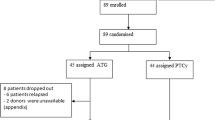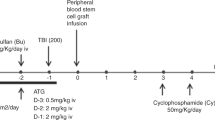Summary:
Reduced-intensity conditioning that harnesses the potential of a graft-versus-tumor (GVT) effect has been proposed as an alternative to conventional myeloablative allogeneic stem cell transplantation. The primary aim is engraftment and this can be achieved with minimal immunosuppression. In this report, we describe the use of such regimens for CML in 17 patients who received human leukocyte antigen (HLA)-matched sibling allografts. Conditioning was with fludarabine, antithymocyte globulin (ATG) and busulfan for the first 11 patients, whereas fludarabine, busulfan and TBI were used for the remaining six patients. Engraftment was prompt in most of the cases. Complications and need for supportive therapy in the immediate post-transplant period were reduced drastically. Only two patients (both in the TBI group) died within the first 100 days. Acute graft-versus-host disease (GVHD) grade II–IV was seen in seven patients. Complications occurred later on. Chronic GVHD was observed in 11/17 patients. Lung infection and GVHD were the major killers. In surviving patients, after a median follow-up of 30 months (range 37–21 months), 6/17 (35.3%) are alive. Five are disease free and one patient is still in relapse even after a second donor lymphocyte infusion. Total treatment time and cost were more than with conventional transplants. We conclude that reduced-intensity transplantation still requires further refinement.
This is a preview of subscription content, access via your institution
Access options
Subscribe to this journal
Receive 12 print issues and online access
$259.00 per year
only $21.58 per issue
Buy this article
- Purchase on Springer Link
- Instant access to full article PDF
Prices may be subject to local taxes which are calculated during checkout

Similar content being viewed by others
References
Passweg JR, Rowlings PA, Armitage JO et al. Report from the International Bone Marrow Transplant Registry and Autologous Blood and Marrow Transplant Registry—North America. In: Cecka JM, Terasaki PI (eds) Clinical Transplants. UCLA Tissue Typing Laboratory: Los Angeles, CA, 1996, 117 pp.
Weiden PL, Sullivan KM, Flournoy N et al. The Seattle Marrow Transplant Team. Antileukemic effect of chronic graft-versus-host disease. Contribution to improved survival after allogeneic marrow transplantation. N Eng J Med 1981; 304: 1529–1533.
Kolb HJ, Mittermuller J, Clemn CH et al. Donor leukocyte transfusions for treatment of recurrent chronic myelogenous leukemia in marrow transplant patients. Blood 1990; 76: 2462–2465.
Slavin S, Nagler A, Naperstek E et al. Non myeloablative stem cell transplantation and cell therapy as an alternative to conventional bone marrow transplantation with lethal cytoreduction for the treatment of malignant and nonmalignant hematologic disease. Blood 1998; 91: 756–763.
McSweeney P, Storb R . Establishing mixed chimerism with immunosuppressive, minimally myelosuppressive conditioning. American Society of Hematology Educational Book. 1999, pp 396–405.
McSweeney PA, Neiderwieser D, Shizuru JA et al. Hematopoietic cell transplantation in older patients with hematologic malignancies: replacing high-dose cytotoxic therapy with graft-versus-tumor effects. Blood 2001; 97: 3390–3400.
Giralt S, Estey E, Albitar M et al. Engraftment of allogeneic hematopoietic progenitor cells with purine analog-containing chemotherapy. Blood 1997; 89: 4531–4536.
Saikia TK, Advani SH, Parikh PM et al. Results of allogeneic bone marrow transplant in chronic myeloid leukemia following conditioning with busulfan and cyclophosphamide. J Assoc Physicians India 1999; 47: 770–773.
Roosnek E, Hogendijk S, Zawadynski S et al. The frequency of pretransplant donor cytotoxic T cells precursors with anti-host specificity predicts survival of patients transplanted with bone marrow from donors other than HLA identical siblings. Transplantation 1993; 56: 691–696.
Cheson B . Infection and immunosuppressive complications of purine analog therapy. J Clin Oncol 1995; 13: 2431–2448.
Panigrahi S, Varadi G, Or R et al. Invasive fungal infections in patients undergoing fully matched allogeneic stem cell transplantation (allo SCT) following non-myeloablative conditioning. Blood 1999; 94 (Suppl. 1): 339a.
Author information
Authors and Affiliations
Rights and permissions
About this article
Cite this article
Das, M., Saikia, T., Advani, S. et al. Use of a reduced-intensity conditioning regimen for allogeneic transplantation in patients with chronic myeloid leukemia. Bone Marrow Transplant 32, 125–129 (2003). https://doi.org/10.1038/sj.bmt.1704107
Received:
Accepted:
Published:
Issue Date:
DOI: https://doi.org/10.1038/sj.bmt.1704107
Keywords
This article is cited by
-
Pushing the envelope—nonmyeloablative and reduced intensity preparative regimens for allogeneic hematopoietic transplantation
Bone Marrow Transplantation (2015)
-
Indications and outcomes of reduced-toxicity hematopoietic stem cell transplantation in adult patients with hematological malignancies
International Journal of Hematology (2013)
-
Passé et futur de la LMC: allogreffe de CSH, omacetaxine et ponatinib
Oncologie (2012)
-
Case-matched comparison with standard versus reduced intensity conditioning regimen in chronic myeloid leukemia patients
Annals of Hematology (2012)
-
Stem cells in clinical practice: applications and warnings
Journal of Experimental & Clinical Cancer Research (2011)



